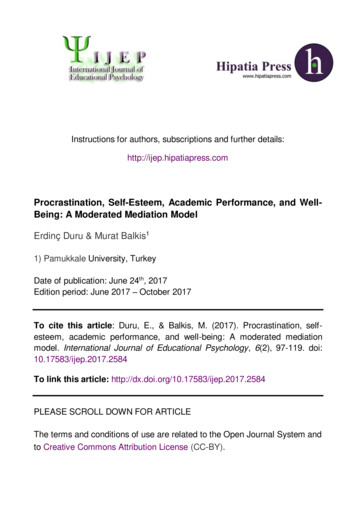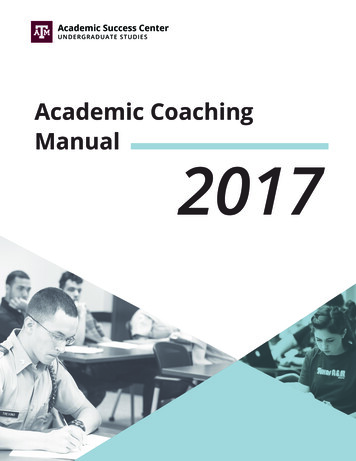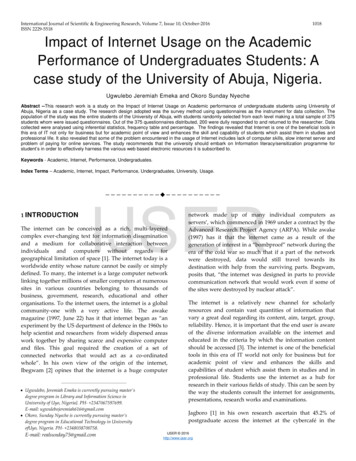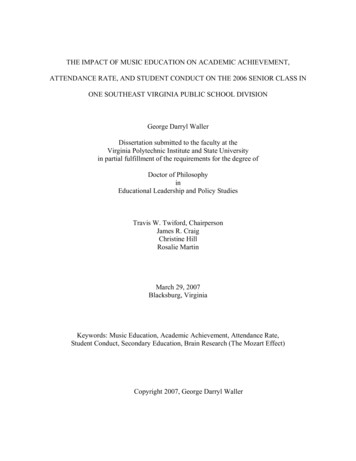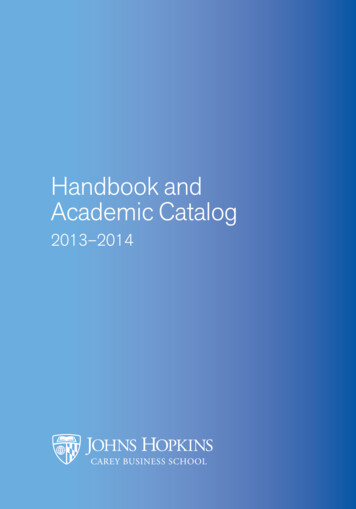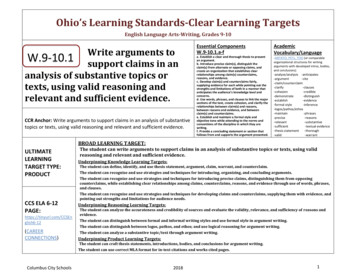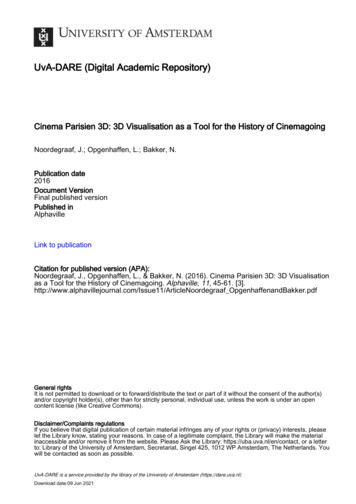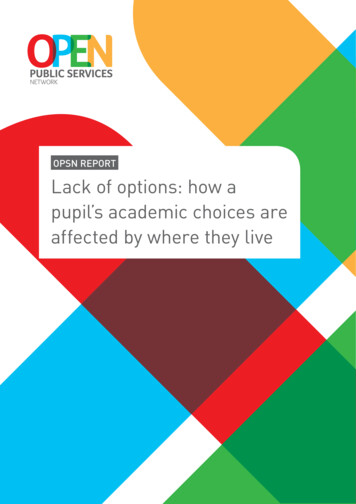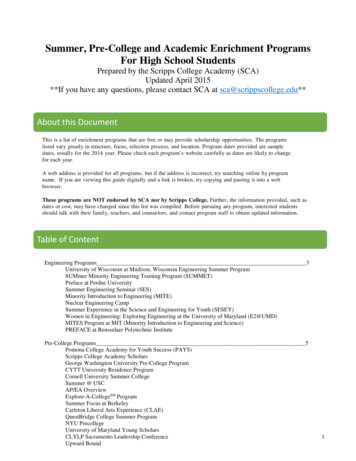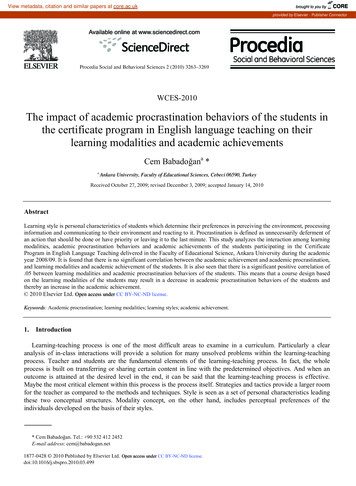
Transcription
View metadata, citation and similar papers at core.ac.ukbrought to you byCOREprovided by Elsevier - Publisher ConnectorAvailable online at www.sciencedirect.comProcedia Social and Behavioral Sciences 2 (2010) 3263–3269WCES-2010The impact of academic procrastination behaviors of the students inthe certificate program in English language teaching on theirlearning modalities and academic achievementsCem Babado ana *aAnkara University, Faculty of Educational Sciences, Cebeci 06590, TurkeyReceived October 27, 2009; revised December 3, 2009; accepted January 14, 2010AbstractLearning style is personal characteristics of students which determine their preferences in perceiving the environment, processinginformation and communicating to their environment and reacting to it. Procrastination is defined as unnecessarily deferment ofan action that should be done or have priority or leaving it to the last minute. This study analyzes the interaction among learningmodalities, academic procrastination behaviors and academic achievements of the students participating in the CertificateProgram in English Language Teaching delivered in the Faculty of Educational Science, Ankara University during the academicyear 2008/09. It is found that there is no significant correlation between the academic achievement and academic procrastination,and learning modalities and academic achievement of the students. It is also seen that there is a significant positive correlation of.05 between learning modalities and academic procrastination behaviors of the students. This means that a course design basedon the learning modalities of the students may result in a decrease in academic procrastination behaviors of the students andthereby an increase in the academic achievement. 2010 Elsevier Ltd. Open access under CC BY-NC-ND license.Keywords: Academic procrastination; learning modalities; learning styles; academic achievement.1.IntroductionLearning-teaching process is one of the most difficult areas to examine in a curriculum. Particularly a clearanalysis of in-class interactions will provide a solution for many unsolved problems within the learning-teachingprocess. Teacher and students are the fundamental elements of the learning-teaching process. In fact, the wholeprocess is built on transferring or sharing certain content in line with the predetermined objectives. And when anoutcome is attained at the desired level in the end, it can be said that the learning-teaching process is effective.Maybe the most critical element within this process is the process itself. Strategies and tactics provide a larger roomfor the teacher as compared to the methods and techniques. Style is seen as a set of personal characteristics leadingthese two conceptual structures. Modality concept, on the other hand, includes perceptual preferences of theindividuals developed on the basis of their styles.* Cem Babado an. Tel.: 90 532 412 2452E-mail address: cem@babadogan.net1877-0428 2010 Published by Elsevier Ltd. Open access under CC BY-NC-ND license.doi:10.1016/j.sbspro.2010.03.499
3264Cem Babadoğan / Procedia Social and Behavioral Sciences 2 (2010) 3263–3269The recent researches in the field clearly set forth the fact that the human brain is specialized and unique as wellas exhibits situational characteristics and within this framework learning should also be considered as a mentalactivity.If the styles of individuals are identified, then it can be envisaged more easily how they can learn and what kindof a teaching design may be implemented. Therefore teacher can create suitable environments both for himself orherself and also for students. As teaching activity is both a science and an art at the same time, teacher should try tomake this process valuable to experience for the learners.Researches indicate that learning process is realized more easily, effectively and permanently in the environmentsdesigned by taking into account the personal characteristics of learners. In ensuring harmonization between learnercharacteristics and method, environment and materials, the most important precondition is identification of thecharacteristics of learner group. Actually, it is impossible to indentify all characteristics of the learners.Characteristic elements generally regarded as effective in the learning process are those reflecting their identity andcultural features, prerequisite competencies learners have and learning styles and preferences of the learners.2.Theoretical Framework2.1. Learning styleLearning style is personal characteristics of students which determine their preferences in perceiving theenvironment, processing information and communicating to their environment and reacting to it. To this end,researches on the correlation between academic achievement levels and learning styles of the students can producebeneficial information for the relevant student group and teachers. Different models and scales are used inidentification of the learning styles. They include various approaches which are used very commonly. This study ismainly based on a point of view including the diagnostic approach which is mainly adopted by Dunn and Dunn. Inthe literature, Dunn (1993a) defines the concept of learning style as “a path which varies for each individual, startswith concentration of the individual on new and challenging information and continues with absorbing and retainingthe information”. When the definitions for the learning styles are examined, it is seen that biological predications arevery intensive. Given the uniqueness of each human being, although styles of individuals do not change, learningstyles can change over time and according to the conditions (Thies, 1979). In the models of learning styles, eachtheorist attaches different levels of importance to the dimensions of the learning styles which are grouped in terms ofcognitive, affective and physiological perspectives. Some of the learning style models developed by the theorists aretouched upon in the following parts of the study.Learning Style Model developed by Dunn and Dunn is based on the idea that individuals have a unique set ofbiological and development characteristics. These exclusive characteristics of the individual are the main indicatorfor how s/he will learn new information and skills. If the learning environments are arranged in accordance withlearning difficulties of students, then quantity and quality of the learning will enhance. Learning Style Inventorydefines 5 fundamental features of the stimulant resources and describes 21 learning styles (Dunn-Dunn and Price1985). Curry supports the validity and reliability of the learning styles inventory, whereas he suggests that somecomponents of the learning styles are in compliance with global/analytical, hemispheric and reflective instructionalpreference structure (Curry, 1990).Dunn and Dunn Learning Style Model, which is one of the most commonly used learning style models, wasdeveloped by Rita and Kenneth Dunn for students with academic deficiency. The basic principle of the Dunn andDunn Learning Style Model is that “Every student learns in different ways”. Dunn and Dunn Learning Style Modelis based on the following assumptions (Dunn and Dunn, 1993b):- It is possible to determine personal preferences of students for the learning environments.- It is possible to arrange the learning environment in order to use different forms of teaching and to meetthe preferences of students. And this develops learning capability of the student.Although the Dunn and Dunn Learning Style Model was first developed to be used in the primary schools,nowadays it is used at each level of education. In implementation of the model, teachers, educational administratorsand staff should pay attention to the following issues:- Most of the individuals can learn.- Learning environments, resources and approaches respond to various learning style strengths.
Cem Babadoğan / Procedia Social and Behavioral Sciences 2 (2010) 3263–32693265-Everybody has learning strengths, but different people have very different learning strengths.There are some individual learning techniques and their outcomes can be measured reliably.If suitable environments, resources and approaches are ensured, students may attain statistically highachievement levels in academic tests and attitude tests.- Many teachers can learn using learning styles as the cornerstone of their own teaching.- Most students can learn with their own learning styles when they concentrate on new or difficultacademic materials.When the researches explaining the correlation between the academic achievement and personal learning styleare examined, it is seen that students learn different from each other, student performance in different subjects isrelated to how students learn in fact; and when student are taught with these approaches and with the resourcessupplementing their learning styles, their academic achievement increase significantly (Price, 2001:9).Fundamental assumptions of the learning style are so simple. According to the learning style assumption, allchildren can learn but they cannot learn in the same way. Different children can learn best with different ways oflearning and there is not a single teaching approach suitable for all children. Learning should be designed andimplemented by taking into account different learning styles. Most of the educators agree on the fact that studentslearn in different ways (Dunn and Dunn 2002:11).2.2.Academic ProcrastinationProcrastination behavior is very common and a serious problem in the era we live in. However it seen thatresearchers cannot reach a consensus on the definition of this phenomenon of procrastination (Ferrari, Johnson andMcCown, 1995).In general, various procrastination types are defined in the relevant literature. These are academic procrastinationincluding leaving the academic duties to the last minute like preparation for exams and doing homework (Slomonand Rothblum, 1984; Milgram, Mey-Tal and Levinson, 1998); life routine procrastination which manifests itself ashaving difficulty in planning routine tasks of daily living and in doing these tasks in time (Lay, 1986); decisionalprocrastination which emerges as procrastination in decision-making in case of conflict situations and variousoptions (Ferrari and Dovidio, 2000); and compulsive procrastination which appears as deferring both the tasks to bedone and also the decisions to be taken (Ferrari, 1991). In another classification, procrastination is grouped into twobasic structures. First one of them is procrastination as personality traits, which is mainly based on procrastination indecision-making and life routine of daily living; second type is conditional procrastination including also theacademic procrastination.Beswick, Rothblum and Mann (1988) examined the correlation between academic achievements and academicprocrastination behaviors of students. In this study, academic achievement is evaluated in terms of draft term papersprepared by students for psychology subject, their grades for these papers and their exam scores for the samesubject. According to the research results, it is seen that there is a significant negative correlation (-.26) betweengrades of the students for their term paper drafts and the academic procrastination behaviors; a significant negativecorrelation (-.21) between their grades for the term paper and the academic procrastination behaviors and again asignificant negative correlation (-.30) between their scores in the final examination of the psychology and theacademic procrastination behaviors. As a consequence, it can be said that there is a negative correlation betweenprocrastination behaviors and academic achievements of the students.In their study, Rothblum, Solomon and Mukarami (1986) examined the cognitive, behavioral and affectivedifferences between the academic procrastinator and non-procrastinator students, and they also look at thecorrelation between academic procrastination and grade point average at the end of the term. They found asignificant negative correlation (-.22) between academic procrastination and grade point average. It was indicatedthat grade point average of procrastinator students are lower than non-procrastinator students. ÇakÕcÕ (2003) alsofound a negative correlation between academic procrastination behavior and academic achievement.Studies on whether academic procrastination and general procrastination behaviors vary by gender put forthdifferent results. Kachgal, Hansen and Nutter (2001) carried out a study on 68 female and 73 male students andfound that academic procrastination behavior does not show a significant difference by gender. In another study,Milgram and Marshevsky (1995) investigated variables in academic procrastination on 115 male and 85 femalestudents in Israel and found that males are much more procrastinator than the females.
32663.Cem Babadoğan / Procedia Social and Behavioral Sciences 2 (2010) 3263–3269MethodThe purpose of this study is to analyze the interaction among learning modalities, academic procrastinationbehaviors and academic achievements of the students participating in the Certificate Program in English LanguageTeaching in the Faculty of Educational Sciences at Ankara University in the academic year 2008/09. Within thisframework, the following questions are aimed to be answered:What is the level of interaction among- general learning modalities and academic achievements- academic procrastination behaviors and learning modalities- academic procrastination behaviors and academic achievementsof the students participating in the Certificate Program in English Language Teaching?The research model of this study is the singular and relational descriptive model which aims at defining thepresence and/or degree of covariance among two or more variables. The subjects of the study are 77 studentsattending the Department of English Language and Literature and participating in the Certificate Program in EnglishLanguage Teaching in the Faculty of Education Sciences at Ankara University in the academic year 2008/09. Inorder to identify learning modalities of the students, a measurement tool of 80 items under 5 main and 19 subvariables was developed by Çelik and Babado an (2004) with an effort to adapt Dunn’s learning style inventory tothe Turkish culture, and in order to identify academic procrastination behaviors, the measurement tool developed byÇakÕcÕ (2003) was used. The answers of the students were collected through an optical form and the data obtainedafter the evaluation of these answers were analyzed by SPSS 13.0 program.4.Discussion and ConclusionA big majority of the subjects that participated in the research were female students. Table 1 shows the relevantdetails.Table 1. Distribution of subjects by 9100.00When the data collection tool entirely consisting of one-way positive items was analyzed on item basis, over halfof the subjects (57.23 %) said that they agree with the expressions related to the modalities. Table 2 shows therelevant details.Table 2. Agreement of subjects to the expressions on learning modalitiesLearning ModalitiesI absolutely disagreeI disagreeI am not certainI agreeI absolutely .9819.4814.3231.6925.54100.00When the learning modalities (preferences) of subjects are considered in terms of main and sub variables, it isseen that the environmental modalities have the highest average (x: 3.35) while the psychological modalities havethe lowest average (x: 2.89). As for the sub variables, emotional guidance has the highest average (x: 4.34) whileuse of global/analytical process under the psychological main variable has the lowest average (x: 2.66).When physical sub variables are analyzed, it can be said that students prefer plenty of bright light. Students agreewith the items on the elements of temperature, environment and sound. Students generally say that they prefer tostudy in warm environments. It is seen that students prefer to study in clean and tidy environment with a high levelof agreement. In terms of sound element, on the other hand, it is understood that students prefer to study in quietenvironments. The global/analytical element under the psychological main variable relates to whether students learnbetter or gradual description by handling only one aspect during processing. Students with global learningpreferences are interested in meanings and consequences as a whole. However, students that prefer analytical
3267Cem Babadoğan / Procedia Social and Behavioral Sciences 2 (2010) 3263–3269learning are interested in one detail at one time within a meaningful sequence. Students’ uncertainty about a study ofwhich limits are determined may be interpreted that students partially expect guidance by teachers when it isevaluated with the relevant items of the tables above. However, when the fact that the students disagree that theylearn one thing at one time is evaluated together with the relevant items, there emerges an inconsistency.Sociological preferences relate to the social environment in which students want to learn. It is seen that CPELTstudents generally prefer to study alone. This finding is in consistency with the finding that students prefer to studyin quiet environments. The adult element refers to receiving guidance from or being in interaction with an adult.While students are uncertain about learning by listening to lessons from an adult, they say that they want to makethemselves and their parents happy by getting high scores as it is seen in the tables above. Physiologicalcharacteristics relate to such characteristics as students’ selection of sense organs and timeframe and whether theyneed to eat something or move while learning. Students generally need to move during learning. They say thatsitting at the desk for a long time and not participating in the process actively impede their learning.Table 3. Averages of the subjects’ learning modalitiesMain/Sub cePhysiologicalVisualAudioTactileEating and Brain hemispheresWay of 33.152.943.273.412.892.664.113.082.993.113.89When the agreement of students to the expressions related to academic procrastination is examined, it is seen inthe Table 4 that agreement of students concentrates on the expressions of barely, sometimes and usually (70.06percent) in a balanced way.Table 4. Agreement of subjects to the expressions on academic procrastinationAcademic 3.6514.83100.00When averages of students’ agreement to the expressions related to academic procrastination are considered, thehighest average is seen in timely submission of assignments and projects. However, it can be said thatprocrastination is more common in less interesting topics. Students show uncertainty particularly in preparation forexaminations. When it is evaluated together with the expression that students do not prepare for classes, the main
3268Cem Babadoğan / Procedia Social and Behavioral Sciences 2 (2010) 3263–3269reasons for procrastination can be seen. It can be concluded that characteristics and preferences of students areignored since a style-based course design is not adopted.Table 5. Averages of the subjects in terms of expressions related to academic procrastinationAcademic Procrastination BehaviorsI submit my assignments/projects in timeI have time to review subjects before examinationsI generally complete my assignments/projects just before the deadlineI leave boring subjects to the last minuteI frequently take break during studying to do something, to talk to somebody, to drink tea or coffee, etc.I am a student who leaves to study to the last minute but who says next time s/he is going to start to study in timeI study a subject from every aspect before an examinationWhenever I start to study I remember some other things that I should doI deal with some other things with no priority as the date of examination is approaching even if I am informed in advance.I leave studying for examinations to the last day without any sound reason even if they are importantI stop studying early to do more enjoyable thingsI leave studying for even important subjects to the last dayIf I prepare a study program, I stick to itI fail some subjects because I leave studying to the last dayI leave my assignments/projects to the last day without any sound reasonsI read the texts assigned for any subject before I go to the classI study regularlyI prepare for the subjects before I go to the classI cannot complete my assignments/projects in timeValue mesSometimesBarelyBarelyNeverWhen the interaction among academic procrastination, academic achievement and learning preferences of thestudents participating in the research is questioned, the current situation becomes clearer. No significant correlationcould be found between academic achievement and academic procrastination (rsp:-0.09/ sdsp: 0.49). This result whichis negative but insignificant is not in line with the research results pointing to a negative significant correlation. Thisis also the case for the correlation between learning modalities and academic achievements of the students (rms: 0.10/sdms: 0.47). However, there is a positive significant correlation of .05 between learning modalities and academicprocrastination of the students (rmp: 0.35/sdmp: 0.35). This means that a course design based on learning modalities ofthe students can decrease academic procrastination and accordingly increase academic achievement.ReferencesAçÕkgöz, K. Ü. (1996). Etkili ö renme ve ö retme, øzmir: KanyÕlmaz MatbaasÕ.American Association of School Administration, (1991). Learning style: Putting research and common sense into practice. Arlington, WA.Babado an, C. (2008a). Stil tabanlÕ ders tasarÕmÕ geliútirme (ingilizce ö retmenli i sertifika programÕ ö rencileri üzerine bir araútÕrma) YabancÕdil bölümleri ve yüksekokullarÕnÕn yabancÕ dil ö retiminde sorunlarÕ kurultayÕ Mu la Üniversitesi 7-9 MayÕs 2008, Mu laBabado an, C. (2008b). “Stil Temelli Ö retim ve Ders TasarÕmÕ” Ö retim ilke ve yöntemleri (Ed: B.Duman) .Maya Akademi YayÕnlarÕ, AnkaraBeswick, G., Rothblum, E. D., & Mann, L. (1988). Psychological antecedents of student procrastination. Australian psychologist, 23 (2), 207217.Curry, L. (1990). A critique of the research on learning styles. Educational leadership, October.Çelik, L. (2004) Teknoloji yo un ortamlarÕn ö renme stillerine uygunlu u doktora tezi AÜ E itim Bilimleri EnstitüsüDunn, R ,K. Dunn. (1993a). Teaching secondary students through their individual learning styles “Practical approaches for grades 3-6.”Boston: Allyn and bacon.Dunn, R, K. Dunn. (1993b). Teaching secondary students through their individual learning styles “Practical approaches for grades 7-12.Boston: Allyn and bacon.Dunn, R. (1988). Learning Styles: Quiet revolution in American secondary school reston, Virginia: NASSP.Dunn, R. (2001). tml (12.12.2001)Dunn, R., K. Dunn, G. Price (1985). Learning styles inventory an inventory for the identification of how individuals in grades 3 through 12 preferto learn, Lawrence, KS:Price systems.Ferrari, J. R. (1991). Compulsive procrastination: Some self-reported characteristics. Psychological reports, 68, 455-458.Ferrari, J. R., & Dovidio, J. F. (2000). Brief report: Examining behavioral processes in indecision: Decisional procrastination and decisionmaking style. Journal of Research in Personality, 34, 127-137.Ferrari, J. R., Jonhson, J. L., & McCown, W. G. (1995). Procrastination and task avoidance: theory, research and treatment. New York: Plenum.Garger, S., P.B. Guilt. (1984). Learning Style: The Crucial Differences. Curriculum Review. 23, 9-12.Gregorc, A.F. (1984).”Style as a symptom: A phenomenological prospective” theory into practice, Vol:23, No:1.Güven, M., Ç. S. Çardak, D. Sever ve L. Vural (2008) Türkiye’de ö renme stillerine iliúkin yapÕlan araútÕrmalarÕn kullanÕlan envanterlerboyutunda incelenmesi. UluslararasÕ e itim bilimleri konferansÕ. Do u Akdeniz Üniversitesi 23-25 Haziran Magosa KKTC.
Cem Babadoğan / Procedia Social and Behavioral Sciences 2 (2010) 3263–32693269Kachgal, M. M., Hansen, L. S., & Nutter, K.J. (2001). Academic procrastination prevention/intervention: Strategies and recommendations.Journal of Developmental Education, 25, 14-21.Keefe, J. W. (1979). Learning style: an overview student learning styles diagnosis prescribing programs. Reston VA: NASSPLay, C. H. (1986). At last, my research article on procrastination. Journal of Research in Personality, 20, 474-495.Milgram, N. N., Mey-Tal, G., & Levinson, Y. (1998). Procrastination, generalized or specific, in college students and their parents. Personalityand Individual Differences, 25, 297-316.Milgram, N.N., & Marshevsky, S. (1995). Correlates of academic procrastination: Discomfort, task aversiveness and task capability. Journal ofPsychology, 129, 145-155.Price, G. Retrieved from http://learn.humanesources.com/ on 07.01.2009.Price, G. Retrieved from http://www.learningstyle.com on 07.12.2001.Renzulli, J. S., Dai, D. Y. (2001). “Abilities, interest and styles as aptitudes for learning: A person – situation interaction perspective”,Perspectives on thinking, learning and cognitive styles (pp. 23 –46),Robert J. Sternberg ve Li-Fang Zhang (Ed.). Mahwah: Lawranceerlbaum associates.Riding, R. & Rayner, S. (1998). Cognitive styles and learning strategies-understanding style differences in learning and behavior-. London:David Fulton Publishers.Rothblum, E. D., Solomon, L. J., & Murakami, J. (1986). Affective, cognitive, and behavioral differences between high and low procrastinatiors.Journal of Counseling Psychology, 33, 387-394.Solomon, L., & Rothblum, E. (1984). Academic procrastination: Frequency and cognitive-behavioral correlates. Journal of CounselingPsychology, 31, 503-509.Thies, A. P. (1979). A brain-behavior analysis of learning styles. -in student-, New Jersey: Prentice-hall.
an action that should be done or have priority or leaving it to the last minute. This study analyzes the interaction among learning . Strategies and tactics provide a larger room . When the researches explaining the correlation between the academic achievement and personal learni
